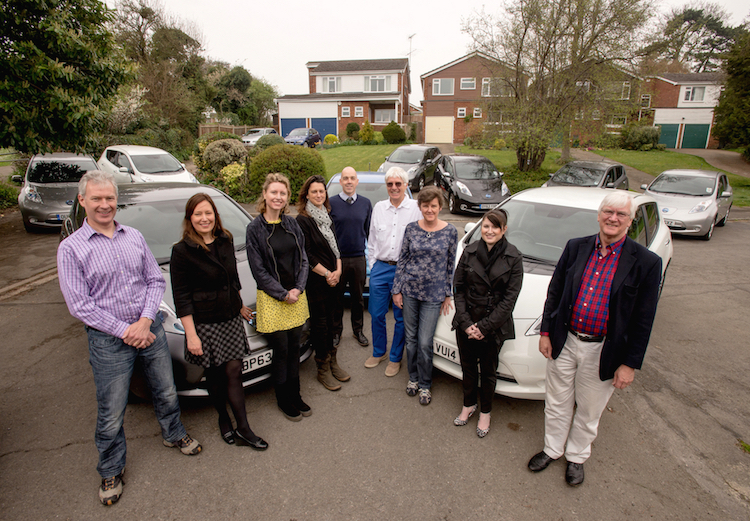My Electric Avenue is a three-year Ofgem-funded project that has been carrying out trials to discover the impact that charging clusters of electric vehicles (EVs) might have on local electricity networks at peak times. As sales of plug-in cars continue to rise*, and as EVs gain ever-larger battery capacities, the trial results show that collaborative action will be needed by the energy and automotive industries to support the growing demand for EV charging in some areas of the UK, and that some of the smart solutions that the industry is developing can help.
My Electric Avenue has been hosted by Scottish and Southern Energy Power Distribution and led by EA Technology. It has been funded through Ofgem’s Low Carbon Networks Fund, with in-kind contribution from key partners. The project has analysed the various kinds of low voltage networks in the UK and four types are expected to experience issues due to the uptake of EVs at differing penetration levels.
By recruiting clusters of neighbours around the country who drove Nissan LEAF electric cars for 18 months, the project teams aimed to mimic a future scenario where many people in an area choose to use a pure electric vehicle or plug-in hybrid electric vehicle (PHEV).
The results, which come at a time when sales of plug-in cars have increased by 716% over the past two years, show that across Britain 32% of low voltage (LV) feeders (312,000 circuits) will require intervention when 40% – 70% of customers have EVs, based on 3.5 kW (16 amp) charging. Susceptible networks are typically characterised by available capacity of less than 1.5 kW per customer.
Traditionally, these findings would mean the replacement of underground cables in the public highway, however My Electric Avenue has been trialling a lower cost solution to this in the form of ‘Esprit’. Esprit is an innovative piece of technology that can control the charging of EVs if the local electricity grid reaches a certain level of demand. By incorporating Esprit into networks, the project is the first real-life trial that has directly controlled domestic EV charging to prevent underground cables, overhead lines and substations being potentially overloaded.
Forecasts suggest that Esprit could save around £2.2 billion of reinforcement costs up to 2050. However, for this solution to work, car manufacturers and the energy industry will need to work together more closely.
My Electric Avenue is now coming to an end and it is disseminating its findings so that energy companies, car manufacturers and others can learn from the project. My Electric Avenue Project Director, Dave Roberts from EA Technology, comments:
“The automotive sector has well established and effective communication channels to discuss industry issues. However, historically there has not been much cross-sector communication between the automotive and energy industries. My Electric Avenue has brought these two sectors together and has started dialogue, and this needs to develop further as vehicle manufacturers announce plans for increasing numbers of higher performance plug-in vehicles.”
Stewart Reid, Head of Asset Management and Innovation at Scottish and Southern Energy Power Distribution adds:
“The project has been invaluable in showing us what challenges we are likely to face in the near future as more and more customers adopt EVs. It’s also demonstrated that there is a solution which is capable of helping us overcome these challenges before they affect our customers. With new vehicles due to place even greater demands on our networks, we are conscious of the need for both ourselves and the automotive industry to share our learning, challenges and innovations with one another. We are excited at this prospect, which will allow the decarbonisation of our respective industries to continue at pace.”
Olivier Paturet, General Manager – Zero Emission Strategy, Nissan Europe said:
“The all-electric Nissan LEAF is a pioneer in its own right and we’re delighted that it has played such a major role in My Electric Avenue’s ground-breaking research. Not only has My Electric Avenue provided us with a greater understanding of the impacts of electric vehicle charging on local grids, but it has also given us a clear vision of what the streets of the future may look like.
EV sales are increasing at a phenomenal rate in the UK and wider Europe and it’s vital that automakers continue to work closely with the energy industry to progress the EV movement. Nissan is already heavily involved in the development of ‘smart grid’ technologies that will allow EV drivers to proactively manage their electricity use at home and we will be making further announcements on this during the coming months.”
There has been a wide variety of learning outcomes from My Electric Avenue, ranging from its successful customer engagement approach to assessing EV drivers’ acceptability of having their charging externally controlled. All the learning is published on the project’s website www.myelectricavenue.info
My Electric Avenue presented the results from the project, and facilitated a discussion about how the UK can deal with this issue going forward, at a ‘Finale’ event in partnership with the event’s host, the Institution of Mechanical Engineers, in London on 3 December 2015.
Source; My Electric Avenue

